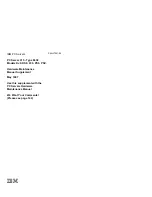
Chapter 5 - Troubleshooting
Host SCSI Channel Problems
61
Host SCSI Channel Problems
Nothing is displayed
on the terminal
emulator screen.
The probable cause of this
problem could be an
incorrect baud rate setting, a
bad communication cable
connection or an incorrect
cable type. Refer to
“Communication Cable
Specifications” on page 87.
If the cable is properly connected,
ensure that the cable is a
null modem
type.
Screen is updated, but
will not respond to
keystrokes.
Improper setting.
Disable hardware flow control on the
terminal or terminal emulator.
Symptom
Solution
The host SCSI BIOS scan
displays “Device name not
available.”
The controller is properly installed, but no arrays have been
created. Use StorView or the VT-100 interface to create an
array, then reboot the host system.
The host SCSI BIOS scan hangs.
Check that the controller port IDs set in the software does
not conflict with any other devices on the host SCSI bus. If
you have a long SCSI data cable, try a different or shorter
data cable.
Only one array is displayed
during host SCSI BIOS scan.
Check to ensure that LUN support is enabled. Most SCSI host
adapters ship with LUN support disabled by default. Use
Display Array Status to check the LUN assignment for each
array. If LUN 0 is not assigned to an array, or some other
LUN numbers are skipped, change the LUN Available option
for each logical drive until you have LUN numbers starting at
0 with no LUNs skipped. You must reboot the host system to
recognize the new LUN assignment.
All logical drives are displayed
during host SCSI BIOS scan, but
only one logical drive is seen by
the operating system.
SCSI drivers for some operating systems require a
parameter setting to enable LUN support. Check the driver
documentation for your host SCSI channel. You may also
need to correct the SAN LUN Mapping LUNs if they are not
sequentially contiguous, i.e., 0, 1, 2, 3, etc.
Symptom
Reason
Solution
4700S.book Page 61 Wednesday, April 6, 2005 2:14 PM
















































